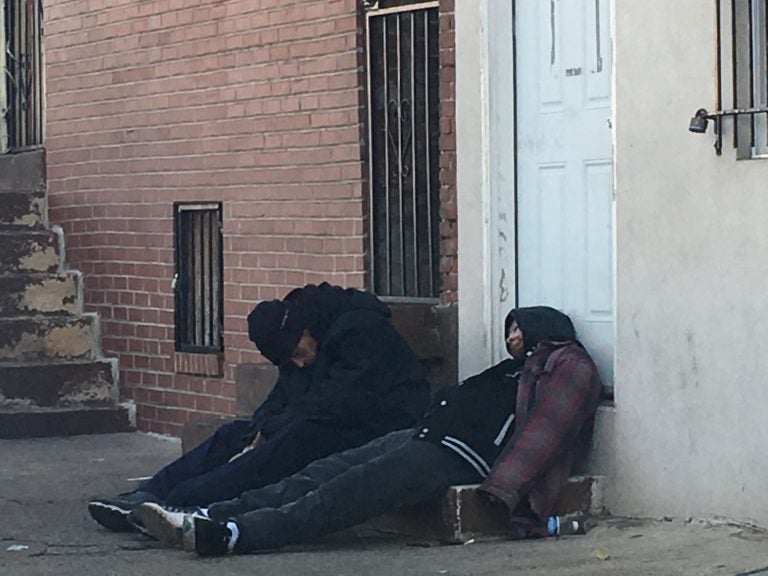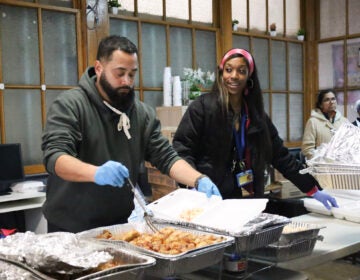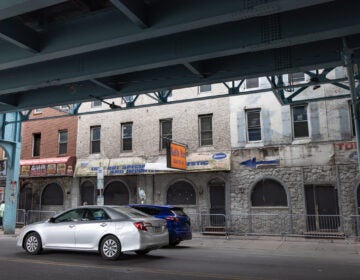Rethinking the Kensington drug crisis
I went to Kensington on Black Friday and saw the devastation of the heroin crisis.

Kensington Avenue on Friday, November 23, 2018. (Solomon Jones for WHYY)
I went to Kensington on Black Friday and saw the devastation of the heroin crisis.
Two men nodded in a drug-addled stupor on a sidewalk on Kensington Avenue. A rail-thin woman with hollowed-out cheeks rushed from beneath the El tracks. At A and Indiana, an anxious crowd gathered, their eyes filled with the weary desperation that is so emblematic of addiction.
Then there was Emerald Street — a tent city under a bridge in the heart of North Philadelphia. In the writhing shadows beneath that overpass, drug addicts have created a house of horrors that a community is forced to witness. They shoot up brazenly, have sex publicly, and die slow deaths at the end of a needle. That’s if they don’t overdose first. Dealers occupy nearby corners. Police ride by and look the other way. All of us die just a little bit faster because that’s what our city has become.
I shot a video of the scene and posted it to social media. It’s been shared more than 13,000 times across multiple platforms. Along with the post I asked a question: Does a safe injection site solve this? The answer, in my view, is no.
Video of addicts and dealers running an underpass and several blocks near Lehigh Ave. How does a #SafeInjectionSite solve this? What a disgrace. pic.twitter.com/WBZYqLCPhS
— Solomon Jones (@solomonjones1) November 24, 2018
Safe injection sites, presented as a panacea by some, are meant to prevent overdoses by allowing addicts to shoot illegal drugs under the watchful eye of medical personnel. There were 1217 overdose deaths in Philadelphia last year. Seventy-five percent of them happened in private homes. As a former addict with 22 years clean, I can assure you that most of those who use at home do so because they don’t want the world to know. That truth, along with the ritualistic nature of addiction — one uses in certain spaces and repeats a certain routine — will likely keep such drug users from utilizing safe injection sites.
And even if street level addicts are willing to forgo the alleys, tents and shooting galleries where they use drugs, the city estimates that such a site will stop between 25 and 75 overdoses — out of more than 1,200. That’s 2 to 6 percent. While every life matters, we can do better than that if we set a goal that involves helping people stop using rather than enabling them to continue.
But treating this new generation of addicts with kid gloves is about much more than ideology. It is also about race. Nationally, almost 80 percent of those who died from opioid overdoses in 2016 were white. In fact, two CDC reports released this year showed that whites were about 50 percent more likely than blacks — and 167 percent more likely than Hispanics — to die from drug overdoses.
Locally, whites also make up the majority of overdose deaths, and that truth remains a driving force behind the push to save the lives of the addicted.
That’s a hard truth for the liberal community to hear, and so the response is often to hurl accusations of race baiting, to dismiss a recitation of the facts as fearmongering or to ignore the facts altogether.
I saw that when I posted the video of drug users and dealers who have taken over Emerald Street in Kensington.
Much of the response was from doctors claiming that we are now “learning” that addiction is a disease. That’s a common refrain that is part of the mythology surrounding the new approach to addiction. The truth is that doctors have known for decades that addiction is a disease. I know. They told me so in the 1990s when I was working my way through a series of rehabs and detoxes in my desperate quest to get clean.
Today the same doctors who were conspicuously silent when black drug users were jailed are openly advocating safe injection sites to help a whiter population shoot drugs.
I asked one doctor who weighed in via Twitter to explain why the approach is so different.
I’m not a doctor, just a writer with an interesting backstory. The language around addiction was quite different during the crack era. So was the approach. So was the level of interest in reducing harm. Why do you think that is doctor? https://t.co/22NQYB5V2o
— Solomon Jones (@solomonjones1) November 26, 2018
Racism. No doubt. We failed people in the 80s & 90s & we continue to fail communities of color now through persistently punitive responses to trauma & addxn. But we are learning that there’s a better way: supportive housing, harm reduction, low barrier treatment. We need it all.
— Jonathan Giftos, MD (@JonGiftosMD) November 26, 2018
Perhaps, but we also needed all of that when black people with addictions were being jailed. That’s why it’s not good enough to acknowledge that racism drives the difference in approach. We must make black communities whole.
That means going beyond the city’s recent agreement to return $3 million in money and property unjustly taken from those accused of drug crimes through its Civil Asset Forfeiture program. The black community should not be silent until all improperly confiscated wealth is returned, until all falsely imprisoned people are home, and until all harm done to our community during the drug war is addressed.
In addition to fixing the inequities of the past, we must also do what is necessary to fix the present disaster that is taking place in Kensington. To do so, city leaders must first acknowledge that they’ve been failing that community for decades.
Our leaders allowed prostitution and drug dealing to become that community’s norm. Our leaders allowed suburban drug users to flood into that neighborhood. Now they tell us that their best solution is to help addicts shoot drugs. And the man spearheading the effort to do so is Ed Rendell — the same man who told me in an interview that, as district attorney, the only option he had to address crack addiction in the 1990s was jail.
Today, we know that a strictly criminal justice approach to addiction is not the complete answer. However, it must be part of the solution. Cleaning up drug encampments in Kensington requires enforcing the law, just like we do in wealthier neighborhoods: No open drug use, no prostitution, and no drug dealing on the street. Then, for those who want treatment, we should find the resources to get them the help they need. Partner city-owned health clinics with major teaching hospitals to provide free and intensive drug treatment. Put city resources into job creation, housing and support services.
Our city’s leaders created the Kensington crisis through decades of neglect. Our leaders must now fix it. They can do so by helping people to get off drugs, because we’ll never fix that community by helping people continue to use.
WHYY is your source for fact-based, in-depth journalism and information. As a nonprofit organization, we rely on financial support from readers like you. Please give today.





